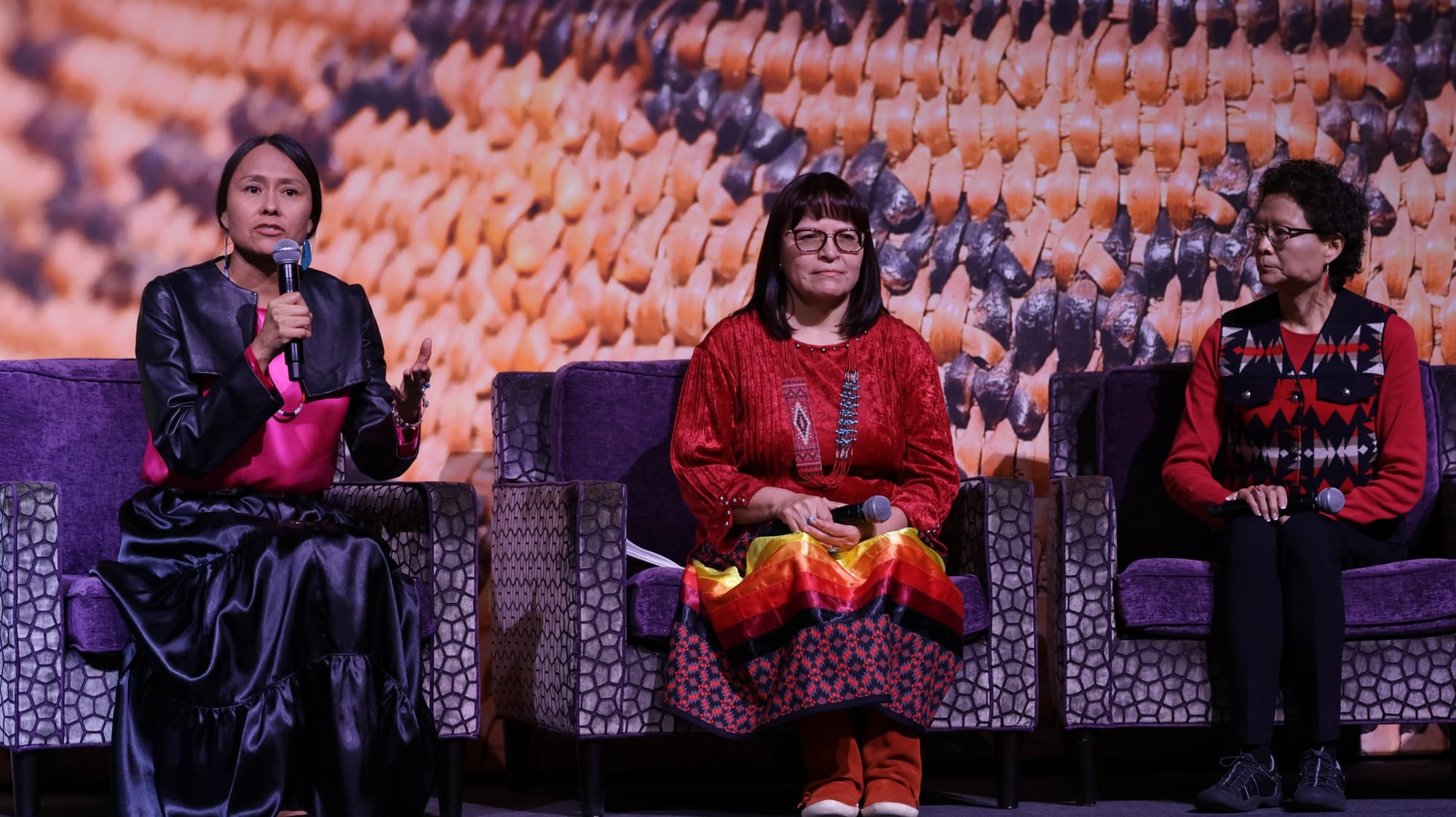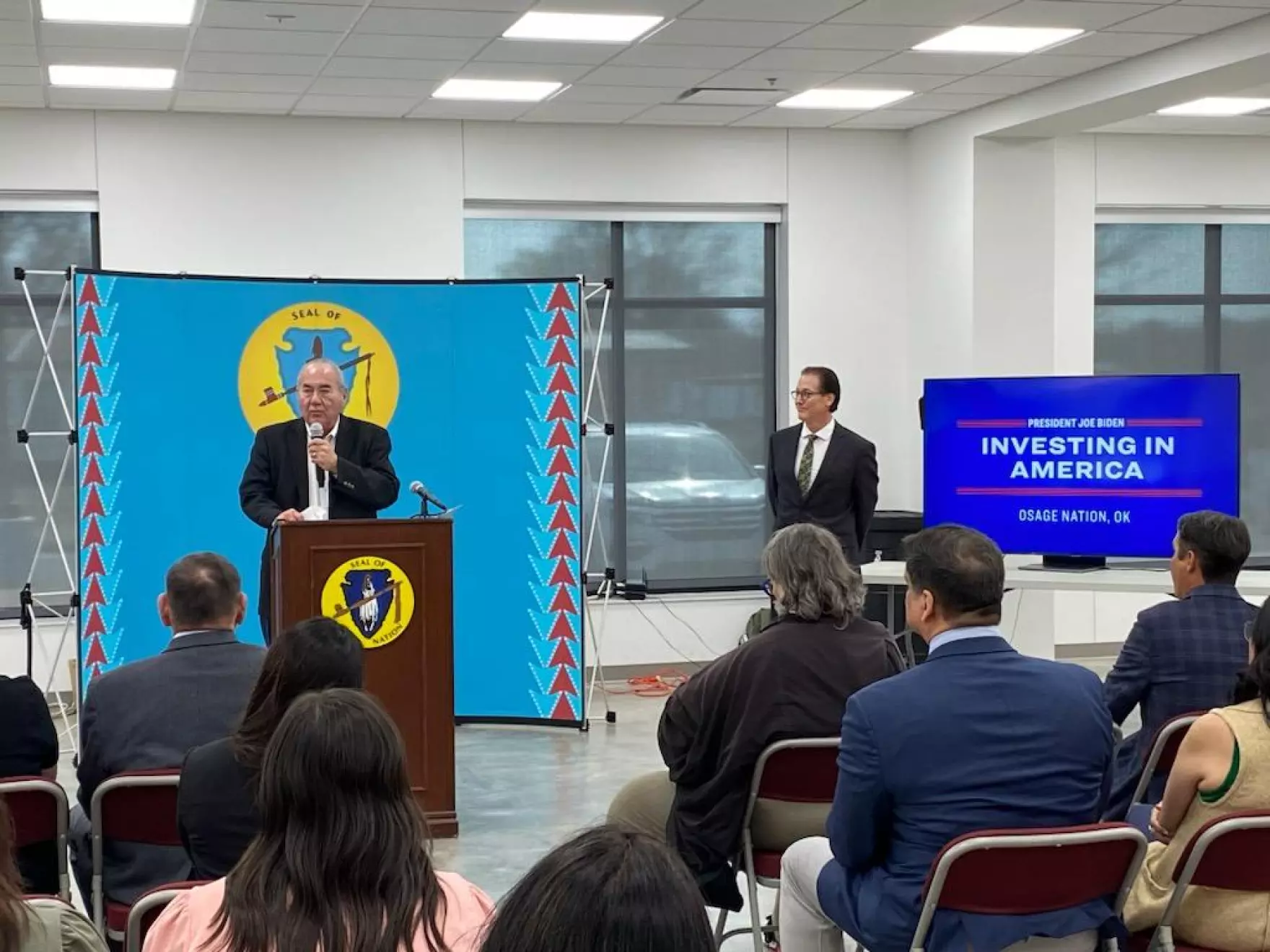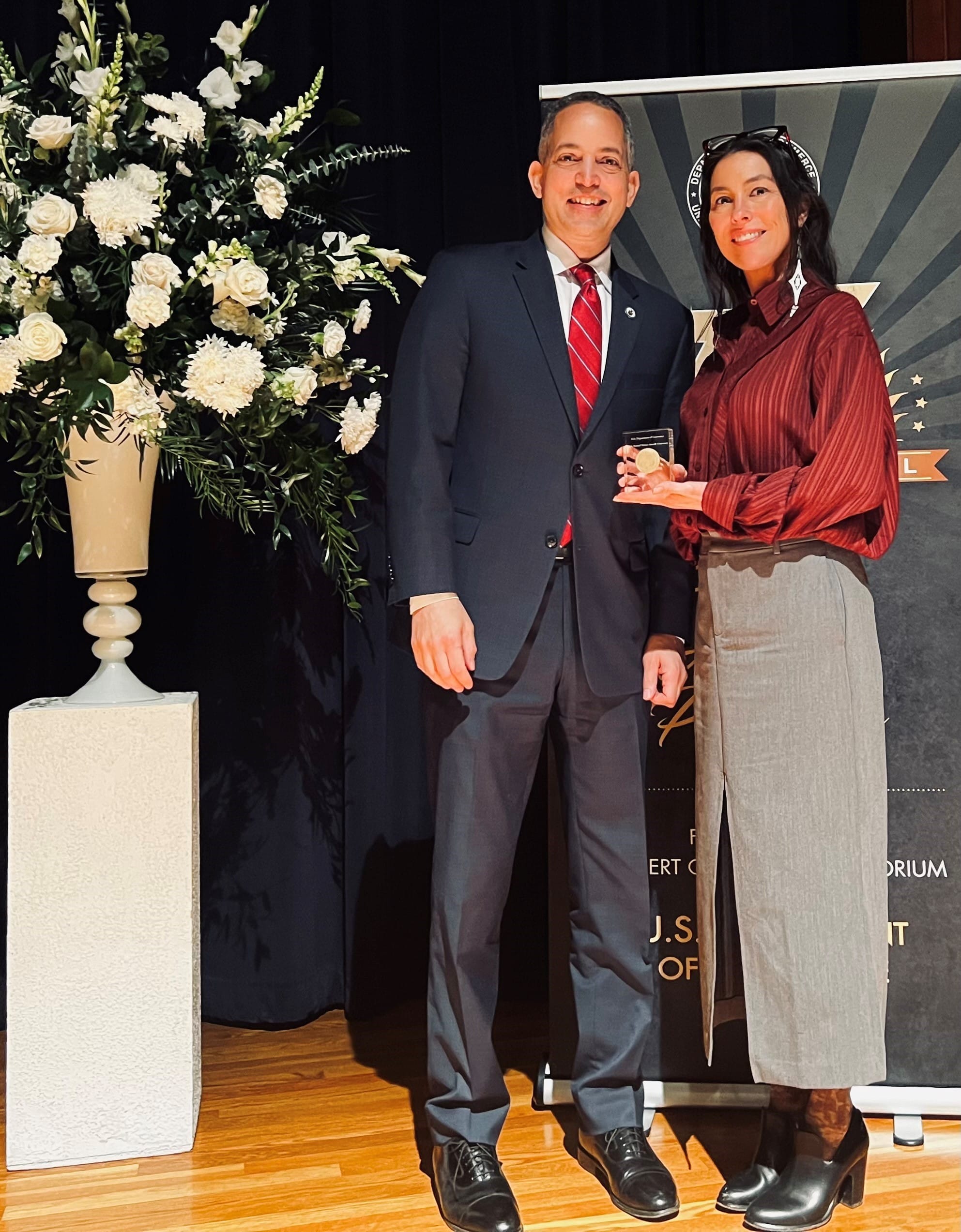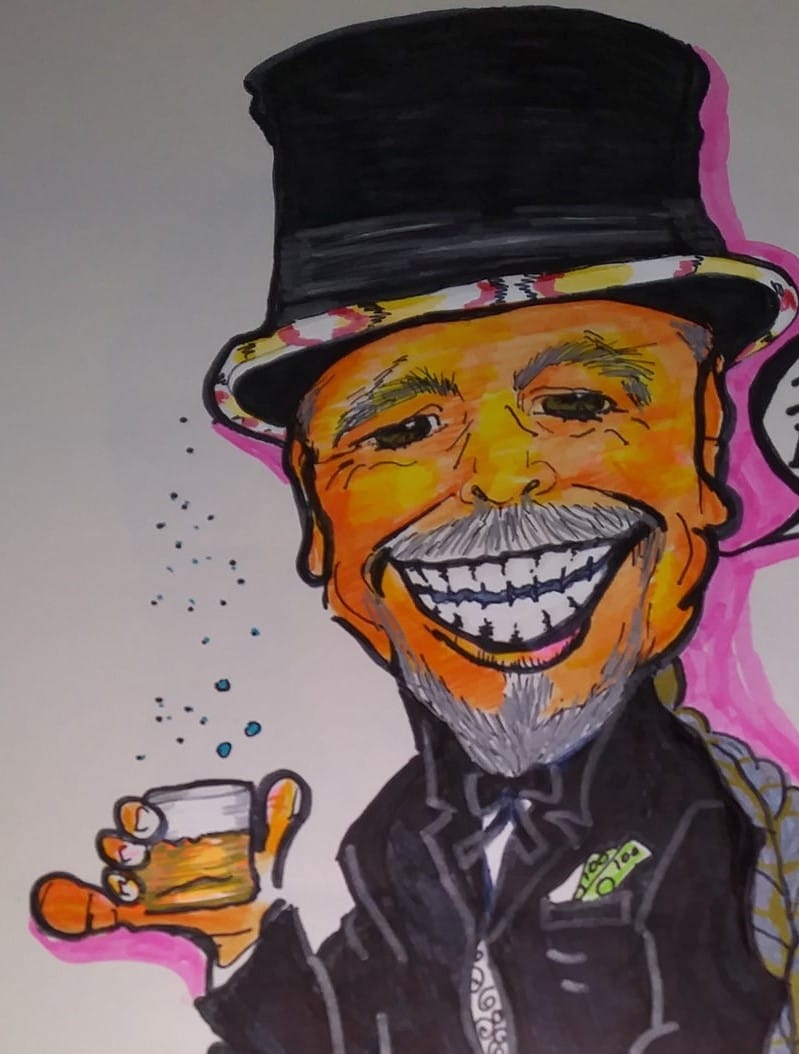

Clean energy dreams, realities highlighted at DOE tribal summit

There was an air of cautious optimism as the Department of Energy convened with tribal, business, and nonprofit leaders during the two-day Tribal Clean Energy Summit last week in Temecula, California.
More than 700 participants gathered on Feb. 27-28 at the tribally owned Pechanga Resort Casino in southern California, meeting with Energy Secretary Jennifer Granholm and Department of Energy (DOE) representatives. Live-streamed panels were accessible online for both the first day and second day. Granholm was on hand to announce more than $400 million in new funding for renewable energy projects, many of them tribal.
The Office of Indian Energy (OIE) engaged in one-on-one sessions with tribal and nonprofit leaders regarding DOE loan programs, grants, and direct tax credits. Other workshops and panels showcased tribal clean energy efforts, such as the Hopi tribe’s transition from coal to utility-scale solar and the Confederated Tribes of Warm Springs’ efforts to improve grid resilience.
“Each of us has a moment of opportunity and leadership. Whether you're elected in your community or appointed to your role, or you're a clean energy developer, you have the power to make big things happen,” OIE Director Wahleah Johns, a member of Navajo Nation, told the audience during her opening remarks. “We organized this summit to make big things happen - to learn, to expand, to network, to find partners to work with and deploy clean energy.”
The event, held for the first time in a tribal venue away from Washington, D.C., was a markedly improved departure from prior summits in the same vein, according to Alliance for Tribal Clean Energy President and CEO Cheri Smith. The efforts to speak directly with tribal leaders in a more comfortable environment led to more engaged, informative discussions, Smith said, though concerns remained around the new funding announcements.
“That is new to this administration, that level of access and that level of engagement face-to-face. The general consensus from people I talked to is that they were really impressed by the event and having more tribes there. We have to applaud Wahleah Johns and her team for creating that,” Smith said. “But the money announcements were bittersweet, because it’s spread across some really nice projects, but it’s still not enough. There are still gaps in making these projects a reality.”
Big dreams, big hurdles
Teamwork was a recurring topic during each of the panels throughout the summit, with frequent praise for the DOE’s newfound outreach efforts and discussions of cooperation and information sharing between tribes embarking on new renewable energy projects.
Panelists shared advice on seeking partnerships with private companies, building a capital stack for larger projects, and turning utility scale projects into revenue drivers.
"Having people ready to do this work is key to what's happening now," said Sandra Begay, researcher and developer at Sandia National Laboratories, during a panel on the Navajo transition toward clean energy. "I think we can't understate the teamwork that is needed."
During her remarks, Granholm pointed to expanded DOE loan guarantees, tax credits, and a surge in outreach and technical assistance. It was the Energy Improvement in Rural or Remote Areas Program (ERA), though, that served as the central pillar of Granholm’s discussion as she announced $366 million in funding allocated to 17 projects across the country, 12 of which were located on tribal lands.
Granholm called the measure “historic,” it was the single-largest amount committed by the DOE to tribal energy projects.
“This [program] was not specifically for tribes. It was just energy improvements, for rural and remote areas,” Granholm said. “It just so happens that tribes submitted overwhelmingly great projects to be able to fund.”
The projects, ranging from solar installations for electrifying rural houses to hydroelectric plants meant to help build out new tribally-owned utilities, will bring economic benefits and improve tribes’ control over their own energy, in addition to combating climate change, Granholm said.
But that’s where the gaps come in, according to the Alliance for Clean Energy’s Smith. The projects in question remain under negotiation, where final funding commitments depend on proving whether or not the selected project can meet the needs outlined in each proposal. Between required matching funds — in some cases as much as 20% of the project cost — the pre-development costs, and systemic barriers, that’s a tall order.
Tribes already face hurdles when it comes to securing funding for energy projects, and while the ERA program was a step in the right direction, everything from costly environmental studies to systemic discrimination when dealing with state and local policies could stop a project in its tracks, Smith told Tribal Business News.
“When you're talking 10% of a utility scale, that's still too much for most tribes,” Smith said. “Then you’ve got your geological studies, your environmental studies, your feasibility studies … you have to de-risk the project. No partner wants to come in with you on these if you can’t completely de-risk the project, and that makes this stuff expensive.”
While those barriers remain, Smith said she had high hopes for the direction the DOE was taking, and again praised the venue and the direct engagement as a sign of better things to come.
David Sickey, former chair of the Coushatta Tribe who works as a senior consultant for the DOE’s Loan Program Office, echoed the sentiment.
Sickey said the summit provided a preview of what was ahead for the agency’s relationship with Indian Country.
“The funds are not just numbers on a balance sheet — they are tools for empowerment, catalysts for change. This summit provided a platform for discussions on how best to wield these tools effectively,” Sickey wrote in a statement to Tribal Business News. “In the wake of the Summit, the responsibility now lies on the shoulders of tribal leaders, policymakers, and advocates to translate the varied discussions into action.”

Osage Nation breaks ground on $40 million in broadband projects

KOSU | By Anna Pope
When it’s all said and done, about 3,000 households in the Osage Nation are expected to have more reliable internet access.
Officials from the nation and the Biden-Harris Administration broke ground on over $40.6 million in broadband expansion infrastructure projects on Monday. Once the work is complete, the area will have more than 200 miles of fiber optic cabling and 16 towers for fixed Wi-Fi.
Funding for the initiative comes from a grant through the National Telecommunication Information Administration’s Tribal Broadband Connectivity Program.
Principal Chief of the Osage Nation Geoffrey Standing Bear said this will benefit the nation.
“This will change our community for the better at many different levels, including education, social connection, health services, and cooperation with our community and communities throughout the world,” Standing Bear said.
The nation received money through federal government grants to build a “Fiber Optic Broadband Network” in 2022. Since then, the broadband projects have brought more jobs to the area and the nation created Wahzhazhe Connect, a new department to support the nation’s broadband infrastructure.
Tom Perez, senior adviser to President Joe Biden and director of the Office of Intergovernmental and Tribal Affairs, said the Osage Nation is one of the first tribal entities to get a grant to start broadband installation.
For Perez, the internet is like water.
“It's a critical public necessity that needs to be affordable and accessible to everyone, and that's what this grant is about,” Perez said.

Imotichey honored for work with the U.S. Census Bureau

After dedicating her life to public service for First Americans, a professional recently received a top honor from the U.S. Department of Commerce for working to improve the relationship between First American tribes and the federal census bureau.
Jessica Imotichey and the U.S. Census Bureau’s tribal relations program team received a gold award for personal and professional excellence from U.S. Secretary of Commerce Gina Raimondo during a Feb. 6 ceremony in Washington, D.C.
Imotichey, a Chickasaw citizen, is a former member of the nine-person team tasked with building a permanent tribal relations program. She served with the U.S. Census Bureau from 2016 until accepting a position with the Chickasaw Nation last year.
“We were able to create a permanent program so now there are staff having ongoing conversations and relationships with tribes. I think that was a great decision on (the census bureau’s) part and I think it says a lot about the tribes that we work with too, because even the tribes asked, ‘Why do you come and talk to us every 10 years, we are still here in between.’ That’s an important distinction.”
Prior to returning to the Chickasaw Nation, Imotichey worked for the U.S. Census Bureau in the Los Angeles region, which covers seven states, including Alaska and Hawaii.
“I managed their tribal partnership program and their congressional partnership program,” she said. “This was during the decennial 2020 census which is the largest federal endeavor. They say it’s the largest federal peacetime operation.”
Previous to 2022, there had never been a permanent tribal program within the census bureau, she said. Therefore, nothing was in place to maintain an ongoing relationship with tribes and tribal organizations.
“The decennial (census) happens every 10 years but in between that time there’re all kinds of surveys, such as the American Community Survey and housing surveys. These are important to tribes because that data is part of what feeds into their funding methodologies for grants. Having accurate data and having a good reflection of the community that you’re serving really helps to provide a good grant application and helps to provide accurate funding for your community,” Imotichey said.
The census bureau also has a geography program that looks at tribal lands and includes trust lands and restricted fee lands as well as tribal statistical designated areas. Making sure geography is correct is vital, she said.
In fact while the Bureau of Indian Affairs (BIA) maintains trust land, the U.S. Census Bureau does all of the mapping for tribal lands.
“So having an accurate representation of what tribal lands look like across the country is really important,” she said.
Another critical issue within Indian Country is data and data sovereignty. The census bureau can also help facilitate in developing a survey instrument for tribes interested in conducting their own census.
“The current director of the U.S. Census Bureau, Robert Santos, is invested in making sure that the bureau has good communication and good relationships with our tribes. He really wants to have a firm and respectful understanding of tribal sovereignty and tribal self-determination. He’s made a great effort in putting an eye on the tribal program and some context around the U.S. Census Bureau’s relationship with tribes,” she said.
National Service
While working with the bureau, Imotichey also managed the states of Alaska and Hawaii. Both have large populations of First Americans, and diverse and challenging geographies.
“We made sure that in each one of our states the first person counted within that state was an American Indian and on tribal lands. In Hawaii, we picked a Hawaiian Homeland area. That was important. We were the only region that did that.”
The first count in the nation of the U.S. Census is always in Alaska. Operations there start earlier due to weather and subsistence living. Imotichey’s team conducted the first count at Toksook Bay, an area that is home to members of the Alaska Native Nunakauyarmiut.
“Our region also kicked off and led the nationwide American Indian media campaign for the decennial census,” she said. “Our tribal team really did a great job in being very focused and strategic. Even during the midst of a pandemic, they still turned out. Some of our tribal communities had higher self-response rates than the national average. We really had an impressive team.”
During her service at the census bureau, Imotichey had an opportunity to invite Chickasaw Nation Governor Bill Anoatubby to a 2019 census kickoff event to speak about the importance of the census. The event was conducted at the National Press Club in Washington, D.C.
Governor Anoatubby was the first-ever tribal leader to speak at the event.
“He did an amazing job. It was awesome to be represented,” Imotichey said.
She still stays in communication with census bureau leadership and served as a speaker for Native American Heritage Month in 2023.
Previously, she facilitated a conversation with U.S. Treasurer Marilynn Roberge Malerba, the first woman and first enrolled member of a First American tribe to serve in the role. Malerba is also the permanent chief for the Mohegan tribe.
“I was really blessed to be able to facilitate a conversation with her in 2022 as part of Women’s History Month.”
Chickasaw support
Imotichey, who has two master’s degrees, said support from the Chickasaw Nation has helped her build a career with a national focus.
“I am grateful for the Chickasaw Nation’s assistance in every possible way in terms of going to college. I was very blessed to receive tribal scholarships and academic support each step of the way. That support has been critical.”
Imotichey received a master’s in public health, with a focus in health administration and policy, from the University of Oklahoma Health Sciences Center and her master’s in legal studies in Indigenous people’s law from the University of Oklahoma College of Law.
She worked for the Chickasaw Nation in Washington, D.C., from 2009-2013, on legislation and policy issues.
“I got to serve as a technical adviser on several national work groups, and so building that network and building those relationships really helped me whenever I transferred into the census bureau many years later, because those relationships were in place. There was already that trust there, which is a big thing within Indian Country. Just making sure you know people who have your best interest at heart.”
After living in Washington, D.C., Los Angeles and Pueblo of Laguna, she returned to live and work within the Chickasaw Nation in 2023.
“Now I’m home,” she said. “I haven’t lived in Oklahoma since 2001, so it was really good to finally come home.”
She currently serves as a health policy and legislative analyst within the Chickasaw Nation Department of Health. She also serves as an alternate delegate to the Centers for Disease Control and Prevention tribal advisory committee and was recently named section and caucus representative on the Oklahoma Public Health Association board of directors.
“Every capacity that I’ve served in, every role in each of the places that I’ve lived, one of the things that’s always been most important to me is making sure that I represent the Chickasaw Nation and Chickasaw people well.
“I carry the people with me and carry the work with me in terms of how I was raised, making sure there’s always this aspect of being a public servant. Accepting an award like this, I really feel like I’m sharing it with my community. It’s not just me, my community built me, so I feel like this is our award.”
About the Honor Awards Program
Since 1949, the U.S. Department of Commerce has granted honor awards in the form of gold, silver and bronze medals. Known as the “Oscars of the U.S. Department of Commerce,” the gold award is the highest honorary award given by the department. It is granted by the department’s Secretary for distinguished performance characterized by extraordinary, notable or prestigious contributions that impact the mission of the department. The U.S. Census Bureau is one of the 13 bureaus under the U.S. Department of Commerce.
Along with Imotichey, other team members receiving the award include: Shadana Sultan, Bernadece Boda, Charles Tippeconnic, Willette Allen, Vicki McIntire, Cathy Lacy, Marilyn Sanders and Julie Lam.
For more information, visit Census.gov.

Fixico Interviews “Blanket Approval” Walters Cryin Waters Class Wallet Scandal
By Fus Yvhikv
Fixico is up to his old tricks again. He misrepresents himself as Sean Hannity with the White Wing KKKonservative Truth Zoom show to score an interview with Cryin Walters, the Oklahoma Superintendent of Public Instruction.
Walters thought this would be a friendly audience and thus an opportune time to publicly continue his jihad against wokeness and diversity initiatives. Neither Cryin Walters nor his press secretary bothered to verify Fixico’s identity. So hungry is Walters for a microphone that he is too lazy to do a Google search on the White Wing KKKonservative Truth Zoom show.
At the appointed time, Fixico starts the Zoom show with Cryin Walters.
“Hello. Is this Cryin Walters?” Hannity (Fixico) asks.
“Yes, this is Cryin. I mean, the Oklahoma Superintendent of Public Instruction.”
“Welcome to the show, Cryin.”
Walters grimaces at Hannity’s (Fixico’s) unwelcomed if disrespectful informality.
“Uh, yeah. Thanks for having me. But please address me as Mr. Superintendent.”
“How about I call you Mr. Super?”
Walters’ face brightens.
“Naw, just fooling with you. How does Blanket Approval Walters sound?”
“Now just a minute,” Walters angrily replies. “I know where you are going with this! Trying to make accusations. I thought you were a true White Wing KKKonservative and would be on my side!”
“You should have done your homework Blanket Approval! We are here today to get the bottom of the scandal you created with unauthorized uses of federal monies and how you are trying to make Class Wallet the fall guy for your gross incompetence and negligence.”
“I resemble those comments! Uh, I mean, I RESENT those comments,” Cryin Walters cries.
“Isn’t it true that you were the one who selected Class Wallet as the state’s contractor to administer and deploy these federal monies?”
“Uh, yeah.”
“Isn’t it true that these federal monies, funneled through the state and your contractor, Class Wallet, were meant for needy families to purchase school supplies?”
“Uh, yeah.”
“And isn’t it true that Class Wallet advised you, Cryin Walters, to establish restrictions on type of items that could be purchased by families?”
“Ahem! Well…..”
“Didn’t Class Wallet tell you, the state’s representative, that lacking restrictions, these debit cards could be used to buy anything unless controls were put in place?”
“Top Ten state!”
“And you responded to Class Wallet’s concerns by saying ‘No restrictions. Blanket approval.’ Isn’t that true, Blanket Approval Walters?”
“Bullstitt! This is all Class Wallet’s fault! Why do you think Gov. Stitt is suing that company? Or at least trying to.”
“The Oklahoma Attorney General, Drew Drummond, has dismissed lawsuits that Stitt has attempted to file against Class Wallet. The Attorney General publicly stated that he has clear and unequivocal evidence that you directed Class Wallet to eliminate any spending controls. And that you ordered Class Wallet to approve any purchases.”
“It is all Class Wallet’s fault. Fake news! Witch hunt!”
“Federal auditors have documented that monies were used to purchase such things as Christmas trees, grills, air fryers, espresso machines, and TVs.”
“Hey, TVs are an educational endeavor. As long as kids aren’t watching woke shows such as Dear White People, Blackish, or reruns of Modern Family or The Brady Bunch.”
“The Brady Bunch? Really?”
“It is soft core porn with overtures of incest!”
“Whatever Blanket Approval. And the sun rises in the West and sets in the East.”
“Hey! I never thought of that! You are right!”
Fixico shakes his head at the realization of how stunningly stupid Cryin Walters is. He decides that two can play the false reality game and the making up one’s own facts.
“So Blanket Approval Walters, did you know that monies you administered were also spent to buy books you want banned such as Gender Queer, Lawn Boy, and Flamer? Because you authorized blanket approval these books you hate were bought with your blessing. How does that make you feel?”
Blanket Approval Cryin Walters suddenly puts his hands to his throat. He commences to cough and wheeze. His breathing becomes loud and labored. His skin turns red, then purple and finally green. His green face resembles the Wicked Witch of the West. Cryin Walters manages to speak.
“Gender Queer? Flamer? This can’t be true! Oh no! Oooh! You cursed brats! Look what you’ve done! I’m melting! I’m melting! What a world! What a world! This world has destroyed my beautiful White Wing Wickedness! I’m melting!”
Blanket Approval Walters explodes and turns into a greenish gray cloud of smoke that slowly drifts away. Fixico sits paralyzed by shock. Then the online audience claps their approval. Shouts of “All Hail Fixico” ring out.
Fixico beams proudly.



